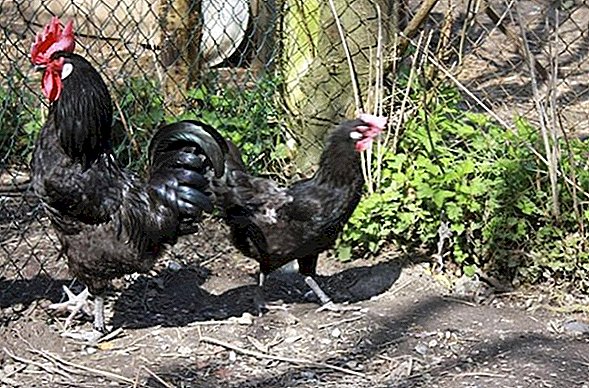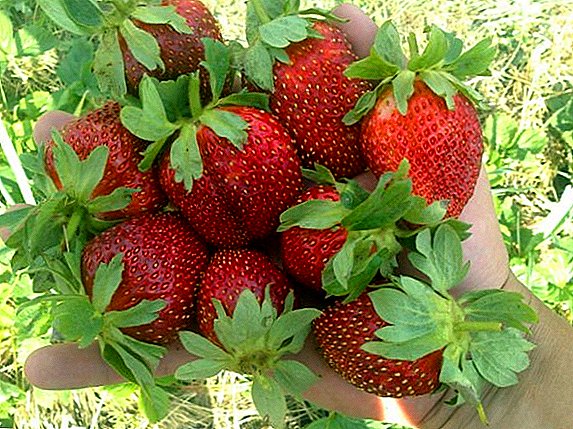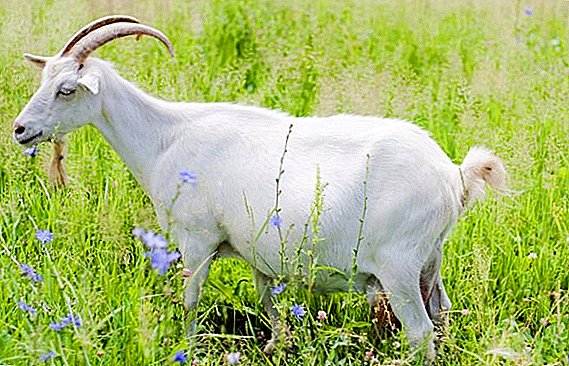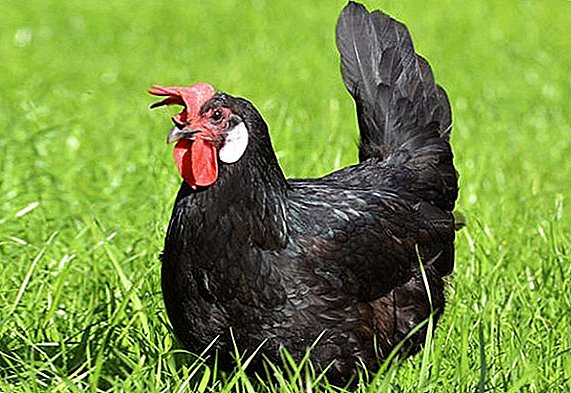 The old French breed of chickens Barbados has long won the respect of Russian farmers. And it is not surprising, because the foreign bird is unpretentious in the care, very quickly adapts to the harsh climate and gives a truly exceptional, delicious meat. We learn more about it.
The old French breed of chickens Barbados has long won the respect of Russian farmers. And it is not surprising, because the foreign bird is unpretentious in the care, very quickly adapts to the harsh climate and gives a truly exceptional, delicious meat. We learn more about it.
History reference
Barbie chickens were first bred a few centuries ago in the small French town of Barbezieux. Initially, birds were not in great demand, so in the XVIII century they were almost on the verge of extinction. We resumed the selection a little later and, despite the lost time, rather quickly recreated the breed in its previous form. And at the end of the XIX century in France appeared barbezie club, which had the most detailed standard of this type.
French layers were delivered to Russia by 2000. Birds very quickly gained popularity and became actively bred in small farms.
Did you know? For the first time, chickens were domesticated about three thousand years ago on the territory of modern Ethiopia, where to this day their images can be found on ancient cultural monuments.

Description and Features
Of the famous French breeds, barbeze chicken is considered the largest and strongest. Birds are markedly different from their relatives by their proud, stately posture and harmonious forms.
Appearance and physique
In addition to a powerful build and tall (male 70 cm, female 65 cm), the breed's distinctive external feature is black glossy plumage (in roosters with green shimmer), which effectively looks against the background of a large scarlet crest and white ear lobes.
Check out the best representatives of meat, egg and meat-egg breeds of chickens.
Detailed external feature:
- head size average;
- the iris is brown with a yellow tinge, from afar the eyes appear black;
- scallop leaf-shaped with pronounced teeth about 10 cm;
- earlobes are white, rather large, in adults up to 5 cm;
- chest powerful, belly convex;
- back extended, slightly tilted back;
- the wings are parallel to the back;
- the limbs are strong, grayish in color, on each paw there are 4 fingers;
- The weight of an adult chicken is about 3.5 kg, of a rooster - 4.5 kg.
 The main defects for which chickens can fall under the culling are:
The main defects for which chickens can fall under the culling are:
- growth mismatch;
- deviation in color from the black color of the body or the gray color of the limbs;
- males have a scallop;
- disproportionate body composition;
- five-fingered;
- too little weight.
Temperament
Farmers who are actively engaged in breeding chickens barbezie, characterize them as good-natured, peaceful, but very curious birds, which should definitely be allocated a large space for long walks. In the fenced area, they will be happy to walk all day in small flocks around the yard, examining all the cracks in search of small nutritious living creatures and grains. The birds and young representatives of the bird's yard will be treated indifferently and calmly.
Maternal instinct nasizhivaniya
Unfortunately, the incubation instinct is practically not preserved in chickens, so that farmers have successfully used another sure method for several years - an incubator.
Learn how to grow chickens in an incubator at home, how to make an incubator device yourself from a refrigerator.

Did you know? Chickens and roosters have relatively well developed intelligence - despite the size of their brains, they can easily determine their owner, recognize more than a hundred people, orient themselves in time of day, memorize the feeding time, and recognize their home area and its neighbors.
Productivity
The type of productivity in Barbados is universal - chickens are able to produce white large eggs and, together with roosters, high-quality delicious meat.
At what age do the average annual egg production begin
Chickens begin to stalk gradually, their maturation occurs at about 5-6 months of life, however, they begin to show the highest figures in the number of eggs after 1 year. Average annual indicators: 150-200 eggs weighing up to 90 grams.  Barbesier eggs are larger
Barbesier eggs are larger
The taste of meat
The main indicator of productivity is exceptional meat. That it made the breed Barbaze popular and valuable. The color of the product is rich red, the taste is described as refined and delicious, and the composition is rich in vitamins and nutrients. This breed is especially appreciated by gourmets.
We recommend that you familiarize yourself with the breeding features of the Brama, Poltava, Leggorn, Rhode Island, Orpington, Redbro, Sussex, Maran, Dominant, Minorca, Foxychik, Faverol, Andalusian chickens.
Herd replacement
The most productive period of the breed in meat and eggs lasts up to two years. In the third year, it is desirable for the farmer to carry out a planned replacement of the herd by the younger generation, since the hens have a natural age-related decline in egg production.
Conditions of detention
In order for the content of French chickens to be as successful as possible and not be accompanied by any negative points, it is necessary to adhere to all recommended conditions verified by many farmers in their personal practice. 
Coop Requirements
The coop must be equipped according to the special requirements of barbezie breed:
- Proper location of perches. Placement should be made at a height of about 40-50 cm from the floor. In no case more, so that the chicken could not break, jumping from a set height.
- Freedom and space. Building up a room for a chicken coop, it should be remembered that for 1 square meter. m can settle no more than three individuals.
- One nest should have an area of 40 to 45 square meters. cm to have up to 15 layers in it.
- Mandatory installation of ventilation.
- A bedding for a nest can be made standard, consisting of straw, shavings, wood ash or slaked lime. Replacement is made partially, only the top layer should be removed.
- It is not necessary to heat the chicken coop - on the contrary, it should be well ventilated (but without drafts!).
- Lighting should not be dim.
Important! It is necessary to avoid any moisture on the litter, so that chickens and roosters do not have painful problems with their paws.
Walking
As noted above, the walking of these pedigree chickens should be done daily and take almost the entire day. The fence can be set low, and the territory of walking - sow young green grass. 
What should take care in winter
The winter cold of the middle zone of the French laying hens is not terrible, however, in the case of prolonged hard frosts (below 8 ° C), birds can experience discomfort and even get sick. Therefore, the equipment of the chicken coop for the winter is another important condition for the successful maintenance of barbezie.
A win-win option will be the construction of frame technology, which allows not only to create a room with a large area, with a capacity of more than 40 chickens, but also provides for the mandatory insulation of materials such as polystyrene foam, foam plastic and mineral wool. Materials are laid between the crate and closed plywood, selected for plating.
In addition, from the cold drafts save well:
- windproof films;
- installation of special internal heaters;
- wooden floor covered with special bedding (straw, dry peat, sawdust 20 cm long).

What to feed adult chickens
In general, barbezie diet is not very different from the menu of other poultry. Chickens can offer homemade mash consisting of millet, barley, oats, corn, peas, bran, sunflower oilcake, shells and salt. In the summer, it is desirable to dilute the dishes with fresh vegetables and grass, and in the winter - pre-dried nettles.
In addition to the basic gastronomic demands, one distinguishing feature of the French breed should be noted - this is a regular need for clay. That it has the main positive effect on the formation of a strong and strong bones. A clay dish must be placed separately with other bowls so that each individual can determine its own daily need.
Important! Representatives of this breed have a tendency to obesity. Overfeeding threatens not just weight gain, but also the cessation of eggs.
Feed barbeze chickens should be strictly 4 times a day, following a simple scheme:
- 1 feeding - dry mix or grain;
- 2 and 3 feeding - vitamin feed and liquid mash;
- 4 feeding - grain or drying.
Breeding chickens
In preparation for the emergence and nursing of young animals, it is necessary to take into account moments related to the characteristics of hatching eggs, caring for chickens and their feeding.
Egg Incubation
As noted above, chickens in Barbados have some difficulties with the incubation instinct, therefore it is better to use an incubator to ensure the chicks are getting. For the manipulation, eggs weighing not less than 70 g are selected, from which viable and active chickens will soon hatch together. 
You can control the quality of the filling material with the help of an ovoscope, which is also easy to do with your own hands.
Nursing care
A few basic rules will help to carry out proper care for thoroughbred chicks:
- Chicks up to 1 month old should not be allowed outside, as they are beginning to late fledge - it is advisable to keep them in a warm place, with an air temperature of 28-30 ° C;
- young barbezie very quickly grows and develops, creating a strong load on the backbone, so from the first days in the diet you need to make mineral supplements;
- for the prevention of various diseases at 8 weeks chickens are recommended to carry out the first vaccination.
Feeding
In the first month of life, the diet of young animals mainly consists of low-fat cottage cheese, crushed eggs (hard-boiled), corn grits and chopped nettle. Starting from the second week, the farmer can gradually add balanced feed, which should become the main food for chickens by the end of the month. After two months, the young can already be transferred to grain and wet mash, not forgetting about nutritional supplements and vitamins.
An important point in the selection of chicken menu is sufficient saturation of food with calcium - a microelement that helps to form strong bones in the hens and roosters and affect their fast plumage. Calcium will help to enrich the diet of chicks with:
- meat and bone meal and fish meal;
- sulfur preparations;
- cottage cheese;
- ant eggs.

Advantages and disadvantages
Based on numerous reviews, it is possible to determine the advantages and disadvantages of keeping barbezie chickens.
Let's start with the benefits:
- high survival rate and good health;
- good adaptation to any climatic conditions;
- quick weight gain;
- high-quality universal poultry products (large eggs and deli meats, similar in taste to game).
- long process of plumage of chickens;
- poor maternal instinct in laying hens;
- propensity to overeat;
- breed rarity.
As you can see, the advantages of this French breed are overshadowed by minor flaws, which even an inexperienced and novice farmer can easily correct with his own efforts. Therefore, breeding chickens barbeze makes sense even in the smallest farms.
Video: Characteristics of Barbie breed
Breed Reviews














